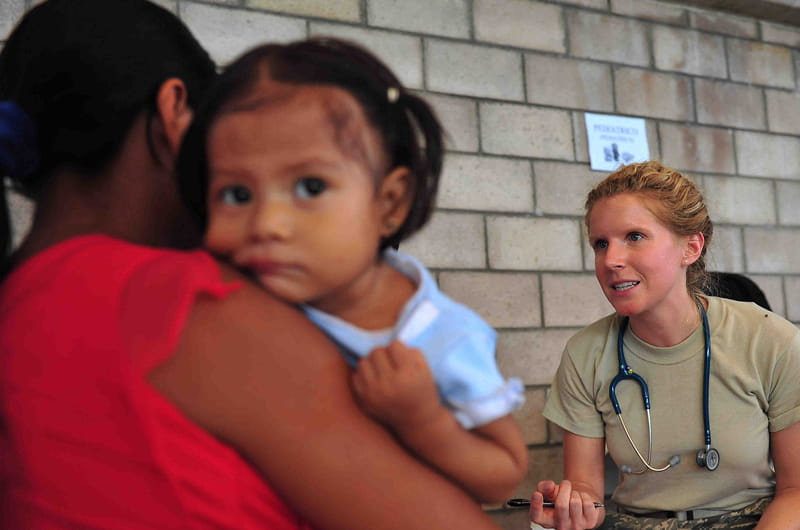Obamacare Led to Gains for Children, But Gaps Persist for Latino Kids
 By Frank Otto
By Frank Otto

- Breakthrough on Gene Therapy for Hereditary Spastic Paraplegia
- Drexel Environmental Collaboratory Releases Cross-Sector Findings on Severe Weather Recovery Challenges
- Drexel Launches the Manuel Stamatakis Center for Alternative Investments at the LeBow College of Business
- How and When Could AI Be Used in Emergency Medicine?

New research shows that the Affordable Care Act (or Obamacare) significantly improved the number of youth in the United States who had health insurance and received well-child visits. However, disparities in insurance coverage and access to care remain, as improvements for Latino youth weren’t enough to narrow the significant gap between them and white and black children.
Alex Ortega, PhD, professor in the Dornsife School of Public Health, led a team that examined national survey results of more than 60,000 youth — who ranged in age from birth to 17 years old — to determine the effect the Affordable Care Act had on children according to race, ethnicity, and family poverty level. They hoped to discover whether the health law increased insurance coverage and improved health care access, as well as whether the large disparities that exist between Latino children and others were reduced in a significant way.
While insurance rates improved for all children, the data showed that insurance rates still remain markedly lower for Latino children when compared with their peers of different races.
“Latinos compose a substantial population group in the U.S. — one in four children now, more than one in three by 2050 — that is generally underserved,” Ortega said. “National and local studies have found that, among children, Latinos have the worst rates of health insurance coverage, health care access, and utilization. Unmet health care needs can result in unnecessary short- and long-term costs to society and families, morbidity, poor educational and professional attainment, and avoidable death.”
From 2011 until 2013, when the Affordable Care Act’s coverage expansions were not fully implemented, to 2014 and 2015, after the full implementation of the law, the portion of white and black youth who did not have health insurance fell from 5 to 4 percent. But Latino children experienced a drop three times that, going from 12 to 9 percent, according to the study, which was published in Academic Pediatrics.
“That reflects an insurance uptake of more than half a million Latino children and over 30% of children newly insured under the law,” Ortega explained. "That is great news but not enough to ameliorate the disparity between them and white and black youth."
Black youth actually experienced a marked closing of the disparities between them and white youth when it came to insurance coverage after the law was implemented. But while Latino children may have benefitted the most from a 25% reduction in uninsurance, they are still more than twice as likely to lack insurance coverage.
Insurance wasn’t the only story, as well-child visits were much more likely for all youth after the implementation of the Affordable Care Act.
“Utilizing well-child visits is very important for prevention and identification of child health problems,” Ortega said. “During well-child visits, health care providers look for problems in growth and development, test for hearing, vision and other concerns, as well as administer immunizations for vaccine-preventable diseases.”
Again, while numbers improved overall, Latino children are still the least likely to have well-child visits, with black children having the highest probability for them, even higher than whites.
One potential issue affecting the disparities seen in Latino children is the Affordable Care Act’s exclusion of undocumented immigrants and recent lawful permanent residents — people legally living in the United States for less than five years.
Compounding that are fears of deportation. While Ortega said that 90 percent of Latino children in the United States are native-born and eligible for state and federal programs, many of them have parents who are immigrants, with one in four of immigrant parents estimated to be undocumented. These families are termed “mixed-status.”
“While children in mixed-status families may be eligible for government programs, the fear of deportation among parents may serve as a barrier for enrollment,” Ortega said. “The Affordable Care Act protects immigrant parents from having to disclose their citizenship status when applying for insurance for their citizen family members, but many do not trust the system.”
To knock down the remaining disparity in health insurance and access, Ortega believes local education and assistance in navigating the system might help. Some states, including California, New York, Illinois and Massachusetts allow for undocumented children to have access to Medicaid.
But all of this could be naught if the Affordable Care Act is repealed and Medicaid programs are cut by one-fourth or more, as proposed by House and Senate Republicans. Ortega is worried that the gains seen — and any chance of reducing disparities — might be wiped away, and even possibly reversed.
“Approximately 93 percent of children had some type of insurance in the pre-ACA period, and that percentage has changed to 95,” Ortega said. “A 2 percent difference might seem trivial on the surface, but this translates to an uptake of insurance for almost 2 million children, which is more than the total population — including adults — of 14 whole states. The changes proposed in the AHCA and BCRA to state Medicaid programs would almost certainly result in children losing coverage, benefits, and access to care.”
Those interested in the full study — co-authored by Ryan McKenna, PhD, and Brent Langellier, PhD, of Drexel; Jie Chen, PhD, and Dylan Roby, PhD, of the University of Maryland; and Héctor Alcalá, PhD, of Stony Brook University —can access it here: “Insurance Coverage and Well-Child Visits Improved for Youth Under the Affordable Care Act, but Latino Youth Still Lag Behind.”
In This Article
Contact
Drexel News is produced by
University Marketing and Communications.